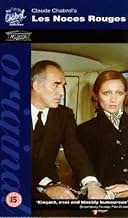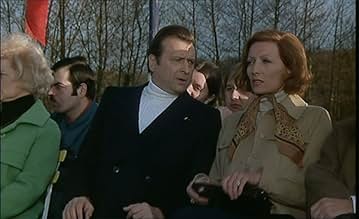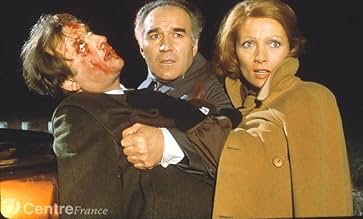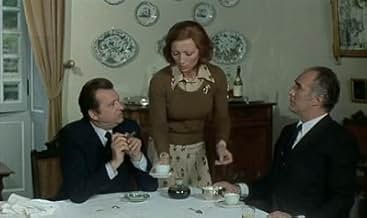IMDb-BEWERTUNG
6,9/10
2144
IHRE BEWERTUNG
Stimmungsvolles Bild einer obsessiven, erotischen Affäre zweier Verheirateter - mit dramatischer Konsequenz.Stimmungsvolles Bild einer obsessiven, erotischen Affäre zweier Verheirateter - mit dramatischer Konsequenz.Stimmungsvolles Bild einer obsessiven, erotischen Affäre zweier Verheirateter - mit dramatischer Konsequenz.
- Regie
- Drehbuch
- Hauptbesetzung
- Auszeichnungen
- 1 Gewinn & 1 Nominierung insgesamt
Empfohlene Bewertungen
A few years after being one of the French New Wave four aces, Claude Chabrol said goodbye to film experiments and embarked on a very active commercial directorial career. For over 30 years he has produced films at a rate of about one each year, most of them thrillers, whose heroes belong to the French bourgeoisie, high or mid-class. 'Les noces rouges' made in 1973 belongs to these years. The setting in which the action takes place is a small French town where everybody knows everybody and where secrets seem very difficult to keep. And yet, from the first scenes of the film we realize that behind the quiet streets and facades, in the villas or apartments of the heroes with comfortable furniture and beautiful objects, there are hidden passions and secrets. Sooner or later, it is inevitable that corpses will show up.
If we were to look for a motto for this film, it would be 'how stupid lovers can be'. With question mark or exclamation mark - you can choose. Lucienne (Stéphane Audran) has an extramarital affair with Pierre Maury (Michel Piccoli), the deputy of her husband, the politician, mayor and representative Paul Delamare (Claude Piéplu). Both are unhappily married, which would be the justification for their infidelity that combines the passion and the grotesque, because in a provincial town like the one where they live (and where they also are public figures) such liaisons are difficult to consume and keep secret. Is murder the only way out? The script is inspired by a true crime case, so it seems that life not only beat the film but in this case even anticipated it.
As in many other films of Claude Chabrol it is difficult to cling to a character and identify with him or her. Paul's sick wife and Lucienne's teenage daughter may be the only innocent figures in this quiet but sinister story, sinister because of the violence that erupts in various forms, and because of the moral decay of the characters, be they criminals or victims. Lucienne's character seemed insufficiently developed, I think it was a much more interesting story than it results from the film in the biography of this woman who begins her life as a teenage mother, marries a man who does not love her but yet she supports his political career and keeps the social appearances, only to fall prey to passion on a path that can only lead to tragedy. Stéphane Audran seemed less inspired than in other films, Michel Piccoli does a good role but not one of his best, and Claude Piéplu, the less famous of the three, manages to create the most interesting character as the husband who accepts his wife's infidelity, being more much interested in his political career sprinkled with dubious business. The thriller plot plays a secondary role, the social commentary and the characterization of the characters seem to be the focal points of the director. Also pay attention to the costumes created by Karl Lagerfeld. 'Les noces rouges' may not be a high point in the career of Chabrol or his actors, but there are enough good reasons to give him a chance to watch or revise.
If we were to look for a motto for this film, it would be 'how stupid lovers can be'. With question mark or exclamation mark - you can choose. Lucienne (Stéphane Audran) has an extramarital affair with Pierre Maury (Michel Piccoli), the deputy of her husband, the politician, mayor and representative Paul Delamare (Claude Piéplu). Both are unhappily married, which would be the justification for their infidelity that combines the passion and the grotesque, because in a provincial town like the one where they live (and where they also are public figures) such liaisons are difficult to consume and keep secret. Is murder the only way out? The script is inspired by a true crime case, so it seems that life not only beat the film but in this case even anticipated it.
As in many other films of Claude Chabrol it is difficult to cling to a character and identify with him or her. Paul's sick wife and Lucienne's teenage daughter may be the only innocent figures in this quiet but sinister story, sinister because of the violence that erupts in various forms, and because of the moral decay of the characters, be they criminals or victims. Lucienne's character seemed insufficiently developed, I think it was a much more interesting story than it results from the film in the biography of this woman who begins her life as a teenage mother, marries a man who does not love her but yet she supports his political career and keeps the social appearances, only to fall prey to passion on a path that can only lead to tragedy. Stéphane Audran seemed less inspired than in other films, Michel Piccoli does a good role but not one of his best, and Claude Piéplu, the less famous of the three, manages to create the most interesting character as the husband who accepts his wife's infidelity, being more much interested in his political career sprinkled with dubious business. The thriller plot plays a secondary role, the social commentary and the characterization of the characters seem to be the focal points of the director. Also pay attention to the costumes created by Karl Lagerfeld. 'Les noces rouges' may not be a high point in the career of Chabrol or his actors, but there are enough good reasons to give him a chance to watch or revise.
By no means one of Chabrol's finest this is nevertheless most watchable and the most agreeable and sinister soundtrack always suggests this may become something much grander. As it is it is a fairly predictable tale with the odd twist but leaves the two leads/lovers ending up looking rather stupid. I'm sure Mr Chabrol, like his mentor, Hitchcock found himself a little less than at ease with the ladies. Hence his wife Stephane Audran and Michel Piccoli, two great actors, but who it has to be said, are both so seemingly lacking in passion, are asked to convince that they would gladly rush to a riverbank or rooms within a stately home to make wild, passionate love. I don't think so! Claude Pieplu is great fun as the at first pompous and later calculating cuckold husband and although we are assured he is not 'up to the job' he seems to have far more fire in him than the other two. Certainly worth watching this is a curious example of the director's work and just goes to show that, again like Hitchcock, even his lesser films are at least interesting, if a little awkward.
Claude Chabrol started as part of the nouvelle vague,as contemporary of Truffaut and -yuk!- Godard ,but his roots are in the old cinema,that of Clouzot and Duvivier.That's why his best movies hold up very well today.
A first golden era included such works as "à double tour" "le beau Serge" and "les cousins".Then came a period of barren inspiration which ended with "les biches" (1967) with which Chabrol entered his most fruitful period the 1967-1973 era:at least five of the works of this time are first-rate works :"la femme infidel" (1968;dubious American remake);"the beast must die" (1969) ;"the butcher" (1969) his towering achievement;"la rupture"(1970) his most underrated ;"juste avant la nuit" (1971) and finally "les noces rouges" which seems today as the last hurrah,a farewell to a golden era.
Unlike the four other films I mention "les noces rouges" is based on a true story which was widely talked about in France of the early seventies.But ,true or not,Chabrol's touch is strong and he makes the story a chabrolesque plot to the core.The bourgeois whom Chabrol depicted in "la femme infidel" or "la rupture" ,and who was played by Michel Bouquet has turned into a caricature.Enter Claude Piéplu,and with his high-pitched voice,he almost overshadows the excellent Stephane Audran and Michel Piccoli.An impotent self-satisfied mean bourgeois with political ambitions ,he accepts his wife's(Audran) affair with his deputy mayor(Piccoli) ,more,it's fine with him because it will be useful for his shady business.The scene when he tells the lovers so is incredible;lines such as "I want everybody to be happy around me!" he delivers to a stunned Piccoli and a bewildered Audran give goose pimples.
You will notice the omnipresence of water:in "que la Bete meure" and "le boucher" ,it symbolized a return from hell,not necessarily a happy end but a world with some peace of mind.In "les noces rouges" it appears during the love scenes (played by the two actors with more gusto than usual :never in a Chabrol movie the carnal act had been -and will be-so much to the fore)as a symbol of innocence (after all, the two people have no sex with their legal partners)in the sin.But it's the heroine's daughter ,called Helene ,who epitomizes innocence and some kind of deus ex machina.
What's more puzzling is that Stephane Audran's characters were all called Hélène in the four other movies I mention:in "la femme infidel' Helene had a lover but with some excuse :her husband appeared like a washout sexually;in "le boucher" she was a brave schoolteacher ,purity flesh on the bone;in "la rupture" her character had to fight against a hostile bourgeois world .In "les noces rouges" Audran ,called Lucienne,is on the other side of the mirror:she really becomes a criminal,almost in a dream .When her daughter,Hélène,who took the place she occupied in former movies asks her "I want you to be happy,mom,please tell me the truth" Audran does not seem to realize all that means.And when she does,it will be too late.
Les noces rouges" is also a movie which depicts political life circa 1970 in a small town where gossips run rampant.And as usual,Chabrol is marvelous when it comes to painting vignettes of ordinary life -see the scene in the library-
It would take Chabrol five years to muster this sort of command ("Violette Nozieres" (1978)),and although he has occasionally made great works ("l'enfer" " la cérémonie" ),he will be remembered in fifty years or so for those gems of the late sixties/early seventies era."Les noces rouges" is a must.
A first golden era included such works as "à double tour" "le beau Serge" and "les cousins".Then came a period of barren inspiration which ended with "les biches" (1967) with which Chabrol entered his most fruitful period the 1967-1973 era:at least five of the works of this time are first-rate works :"la femme infidel" (1968;dubious American remake);"the beast must die" (1969) ;"the butcher" (1969) his towering achievement;"la rupture"(1970) his most underrated ;"juste avant la nuit" (1971) and finally "les noces rouges" which seems today as the last hurrah,a farewell to a golden era.
Unlike the four other films I mention "les noces rouges" is based on a true story which was widely talked about in France of the early seventies.But ,true or not,Chabrol's touch is strong and he makes the story a chabrolesque plot to the core.The bourgeois whom Chabrol depicted in "la femme infidel" or "la rupture" ,and who was played by Michel Bouquet has turned into a caricature.Enter Claude Piéplu,and with his high-pitched voice,he almost overshadows the excellent Stephane Audran and Michel Piccoli.An impotent self-satisfied mean bourgeois with political ambitions ,he accepts his wife's(Audran) affair with his deputy mayor(Piccoli) ,more,it's fine with him because it will be useful for his shady business.The scene when he tells the lovers so is incredible;lines such as "I want everybody to be happy around me!" he delivers to a stunned Piccoli and a bewildered Audran give goose pimples.
You will notice the omnipresence of water:in "que la Bete meure" and "le boucher" ,it symbolized a return from hell,not necessarily a happy end but a world with some peace of mind.In "les noces rouges" it appears during the love scenes (played by the two actors with more gusto than usual :never in a Chabrol movie the carnal act had been -and will be-so much to the fore)as a symbol of innocence (after all, the two people have no sex with their legal partners)in the sin.But it's the heroine's daughter ,called Helene ,who epitomizes innocence and some kind of deus ex machina.
What's more puzzling is that Stephane Audran's characters were all called Hélène in the four other movies I mention:in "la femme infidel' Helene had a lover but with some excuse :her husband appeared like a washout sexually;in "le boucher" she was a brave schoolteacher ,purity flesh on the bone;in "la rupture" her character had to fight against a hostile bourgeois world .In "les noces rouges" Audran ,called Lucienne,is on the other side of the mirror:she really becomes a criminal,almost in a dream .When her daughter,Hélène,who took the place she occupied in former movies asks her "I want you to be happy,mom,please tell me the truth" Audran does not seem to realize all that means.And when she does,it will be too late.
Les noces rouges" is also a movie which depicts political life circa 1970 in a small town where gossips run rampant.And as usual,Chabrol is marvelous when it comes to painting vignettes of ordinary life -see the scene in the library-
It would take Chabrol five years to muster this sort of command ("Violette Nozieres" (1978)),and although he has occasionally made great works ("l'enfer" " la cérémonie" ),he will be remembered in fifty years or so for those gems of the late sixties/early seventies era."Les noces rouges" is a must.
Les noces rouges is, first, just a correct film. You recognize Claude Chabrol in each scene , and the performances of Stephane Audran, Claude Pieplu , Michel Piccoli is one of fundamental marks. It is not the film to convince - the love affair between Lucinne and Pierre is only conventional, the effort of Pieplu reminds the steps of many politicians,Eliana de Santis gives her the best , in minimalism frame, reminding the rafinated cruelty of childhood, Clotilde Joao seems perfect in the shadow of the character of Clotilde Maury.Like many films of Chabrol, Red Wedding gives not exactly a story but the precious lavor of melancholy.
This film has a persistently artificial feel to it that at times serves it well and at times is a hindrance - it sometimes serves to highlight the hypocrisy and corruption of the milieu and give the central characters a decadent air, but at times it interferes with character development, as it interferes with our understanding of the characters. The plot itself is rather conventional but is essentially an excuse to dissect a certain milieu. The most interesting character is in my opinion very underrated: the mayor's stepdaughter, who is clearly intelligent, somewhat sombre but decidedly not bookish. She is the sole character that does not seem motivated by purely selfish, fairly conventional motives (money, political ambition, boredom, sexual desire, etc), making her motivations harder to fathom. She is the only character with any real mystery about her; it's hinted she has some kind of fascination with death, and she makes a surprising comment related to the role of women, all of which add to her ambiguity as a character.
Wusstest du schon
- VerbindungenFeatured in Biester (1995)
Top-Auswahl
Melde dich zum Bewerten an und greife auf die Watchlist für personalisierte Empfehlungen zu.
- How long is Wedding in Blood?Powered by Alexa
Details
- Erscheinungsdatum
- Herkunftsländer
- Sprache
- Auch bekannt als
- Wedding in Blood
- Drehorte
- Valençay, Indre, Frankreich(main location: street scenes, cemetery, Maury's apartment 31 Rue de la République)
- Produktionsfirmen
- Weitere beteiligte Unternehmen bei IMDbPro anzeigen
- Laufzeit1 Stunde 35 Minuten
- Sound-Mix
- Seitenverhältnis
- 1.66 : 1
Zu dieser Seite beitragen
Bearbeitung vorschlagen oder fehlenden Inhalt hinzufügen

Oberste Lücke
By what name was Claude Chabrol's Blutige Hochzeit (1973) officially released in Canada in English?
Antwort
























